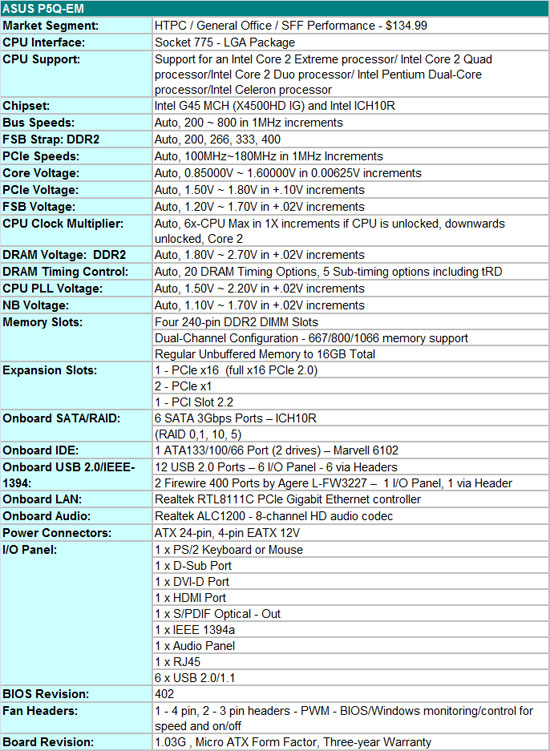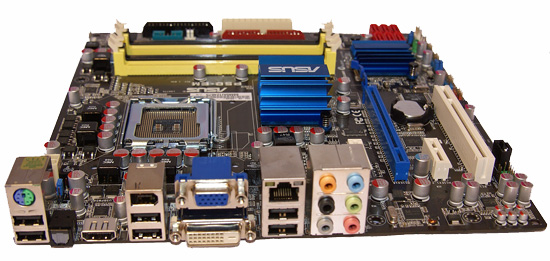The IGP Chronicles Part 1: Intel's G45 & Motherboard Roundup
by Anand Lal Shimpi & Gary Key on September 24, 2008 12:00 PM EST- Posted in
- Motherboards
ASUS P5Q-EM
Our first board up is the ASUS P5Q-EM, which is a worthy successor to the G35 based P5E-VM HDMI. In addition to being the first board that we discuss today, it also happens to be our favorite “all around” board. All four of our boards perform almost identically when it comes to high-definition playback and they all score similarly in our IG based tests. However, if you want a uATX board for your SFF gaming system or plan on overclocking then the ASUS board is a logical choice. Of course, our uATX P45 based DFI P45-T2RS Jr might disagree, but that is a discussion for another time.

In the meantime, the P5Q-EM is a feature rich G45 board featuring an OC friendly BIOS, Gigabit LAN via the almost universal Realtek RTL8111C, IEEE 1394a support, full RAID support along with six SATA ports via the ICH10R, PATA support comes by way of the Marvell 6102, and HD audio via the Realtek ALC1200. Think of the ALC1200 as being the same chipset used by Gigabyte this past year, the ALC889a. However, ASUS does not provide DTS Live and Dolby Home Theater capabilities that Gigabyte does although we understand ASUS is working with DTS on an upgrade. However, one of the main attributes for purchasing a G45 based board is for the multi-channel LPCM output capabilities.
ASUS also provides their Express Gate technology that allows you to access the internet or utilize the most popular IM programs without booting into the OS. Also featured is their EPU-4 engine that provides additional power savings by detecting load conditions and adjusting power in real time. We will have a dedicated look at ASUS' EPU, DES from Gigabyte, and DrMOS from MSI shortly. In the meantime, we were able to save a few watts at various times over the traditional C1E/Speedstep BIOS settings. Fan control and monitoring is good with the capability to set fan speeds based upon thermal conditions in the BIOS or Windows.

In our opinion, ASUS provided an excellent layout considering the space limitations on a Micro ATX board. If the board is utilized in a SFF gaming system, the user is still left with a free PCIe x1 and PCI slot when using a dual slot video card. The heatsink designs did not interfere with a variety of peripherals that we installed including several popular CPU fan/heatsinks and video cards. We have noticed the G45 MCH running a little hot at times but the heatsink design from ASUS was more than capable during testing. We are still waiting for the official death of the floppy drive (and soon the IDE port but we still see value in IDE for a little longer) so the area where these connectors are located can be reclaimed.
ASUS utilizes an excellent four-phase power delivery system along with decent solid capacitors throughout the board that resulted in very stable operation with everything from a Q9650 down to a heavily overclocked E2180. The inclusion of a PS/2 combo port for either a keyboard or mouse is a nice touch for now as we see most suppliers dropping PS/2 support shortly. Other niceties included output support for VGA, HDMI, or DVI-D along with a Firewire port on the IO panel. Overall, the layout is clean, unobtrusive, and will work well for a vast majority of owners.
Pros/Cons
We have to be honest here, up until BIOS 0402, we were not that enamored with this board from an enthusiast's viewpoint. Sure, the basic functionality was there and all peripherals worked fine for a HTPC setup, but the board was not living up to its BIOS options. While this is not important for the vast majority of users looking at IG boards, it is important for users who will use this board as a crossover for a performance oriented SFF system. Our problems ranged from lack of support for the E8600 and Q8200 processors to 8GB compatibility under Vista 64. Additional problems were incurred when overclocking the system as we consistently hit a wall around 415FSB with a 4GB configuration and VCore tended to undervolt severely when set above 1.45V, although with the newer EO steppings you should not have a need for volts that high. Fortunately, most of our performance problems have been solved including overlcocking with memory ratios other than 1:1.
While still not perfect, we were able to attain 455FSB with our Q9300 and 485FSB with the E8600 with aggressive timings, a discreet video card, and 4GB. We are not going to show in-depth overclocking results in today's article since it is oriented towards the chipset introduction with intended use for an office or media application platform. However, if you need an uATX board that offers very good overclocking performance for mainstream users, this board will not disappoint with a discreet video card. We hit a 412FSB wall with the integrated graphics set, not bad at all actually. While video performance is not improved, it is a good way to improve encoding performance with a lower speed processor.
Moving on to more important items for most of us, except for driver, strict EDID adherances, and BD playback problems that are the responsibility of Intel, this board performed admirably throughout IG testing. In our particular setups, we did not have any real problems except for 8GB compatibility under Vista 64 up until BIOS 0402. That said, we think ASUS made a mistake not including an eSATA port on the IO panel. We are also not fans of VGA output or continuing with floppy drive support in this market segment. Both choices would likely be viable options for certain business environments, but we do not see their usefulness in this particular target market. The board worked perfectly when resuming from an S3 state and consistently outperformed the other boards in time to desktop measurements.
While we like the combo PS/2 mouse/keyboard port since it is better than none (yes, we still like the PS/2 keyboard port when overclocking or changing BIOS settings), users with certain wireless keyboard/mouse setups will have to think about upgrading. In fact, PS/2 port availability is something we openly debate, some openly love their inclusion, and some of us just wish we would finally get rid of the legacy ports. We would not have minded a coaxial SPDIF port or IR capability either. Overall, the feature set is impressive for a uATX board and if we only had one wish, it would be adding an eSATA port to the rear IO panel. To reiterate our opinion about this board, if you need a uATX board with versatility then we think this is the board for you.















53 Comments
View All Comments
Olyros - Sunday, February 8, 2009 - link
I noticed there's a mention in the article about searching for the perfect mini-itx case. The Nexus Psile case that I'm using for my Intel "DG45FC"-based computer is perfect for it I think. Especially if you are after stylish and quiet computers.Here are a couple of links for you to check it out if you want:
www.psile.com
http://www.3dgameman.com/forums/showthread.php?t=4...">http://www.3dgameman.com/forums/showthread.php?t=4...
lubama - Tuesday, October 14, 2008 - link
Quote from "Intel's G45 Motherboard round up"However, at various times after the system has gone to sleep it will wake back up without intervention for a few seconds and then shuts down. Sometimes this a few minutes after entering sleep mode, other times it occurred an hour or so later. The board requires a full power cycle to come back to life and does not always resume to Vista, instead we receive the error that Vista has been incurred an error after entering the OS."
Have you found a solution to this problem, seems like you are the only person, other than me, who is catching this issue. I have posted in numerous DG45ID forums and this exact issue is non-existent and haven't received any answers.
IntelUser2000 - Sunday, October 12, 2008 - link
Anand, G965/G35/GM965 has 8 EUs(Execution Units), but each of the EUs contain 2 cores, meaning it has 16 cores. Each cores can also process 2 threads, meaning it has a maximum of 32 thread capability. From that, its not comparable to Nvidia, nor ATI so Intel have their own performance metric.For G45, I assume its 10 EUs, 20 cores. Intel papers mention 50 threads.
puddnhead - Wednesday, October 8, 2008 - link
I second (thrid? fourth? fifth? 9th?) the call for the part 2 (what it's pretty obvious everyone is more interested in anyway, not this article).I wonder if you coudl at least give us an ETA of not the article itself? You know, if it's this week, this month, or ??? Thta doesn't seem too much to ask, I'm surprised you don't give that from the start.
computerfarmer - Friday, October 3, 2008 - link
Looking forward to part_2.I hope they are sooner than the promised reviews from these articles.
AMD SB750 arrives on the Foxconn A79A-S...
Date: July 21st, 2008
Author: Gary Key
http://www.anandtech.com/weblog/showpost.aspx?i=47...">http://www.anandtech.com/weblog/showpost.aspx?i=47...
AMD's SB750: Enabling Higher Phenom Overclocks?
Date: July 23rd, 2008
Topic: CPU & Chipset
Manufacturer: AMD
Author: Gary Key
http://www.anandtech.com/cpuchipsets/showdoc.aspx?...">http://www.anandtech.com/cpuchipsets/showdoc.aspx?...
AMD 790GX - The Introduction
Date: August 6th, 2008
Topic: CPU & Chipset
Manufacturer: AMD
Author: Gary Key
http://www.anandtech.com/cpuchipsets/showdoc.aspx?...">http://www.anandtech.com/cpuchipsets/showdoc.aspx?...
computerfarmer - Friday, October 3, 2008 - link
When is PART_2 coming out?duploxxx - Friday, October 3, 2008 - link
Lots of talk of bringing a great roundup of chipsets...already for a few weeks now.Where does anand start? at the least interesting and the most garbage chipset for several years now.
lets hope your global review is as good as people expect it to be.
you started off already a bit better then you did in recent gpu reviews, you actually took a cpu that was rather common to be used, although a e7200 or Q8200 would be a much better fit for this kind of boards.
whosthere - Tuesday, September 30, 2008 - link
I didn't see any specifics on the Game Settings. Could you please post them...Thanks
dutchroll - Monday, September 29, 2008 - link
Yeah I was thinking much the same thing about the "fanboi" comments.Can they spell "hypocrite"? It really betrays your allegiance when you rant at Intel then go all wobbly and weak at the knees while mentioning AMD. AT are damned if they do, damned if they don't as far as reviewing either brand's offerings. They've already stated how good the 780G was. They've stated what bugs are in the G45. So what the heck is the problem?
piesquared - Wednesday, October 1, 2008 - link
The problem is, they promised a SB750 review 2 months ago. The problem is they promised a DFI LP JR. review 1 month ago. The problem is they go well out of there way to avoid any comparison of Intel's ITD, and AMD's IGP. So what if they obscure and bury a line inside an Intel article that gives credit to AMD hardware. They fail to give credit where credit is due, and it is glaringly obvious. And it's even more obvious when this article pops up suddently when Intel has a new driver. They were waiting on Intel's promises of a new driver that would improve performance, and show it's hardware in a better light. Doesn't matter if you crap in a plastic or paper bag, it's still a bag of shit though. I'll make a wager that none of the upcomming "promised" reviews will have any side by side comparisons of Intel's IDT, to any other IGP. Unless of course AT stalls long enough to allow Intle more time to produce yet another driver.....